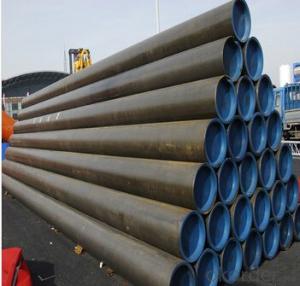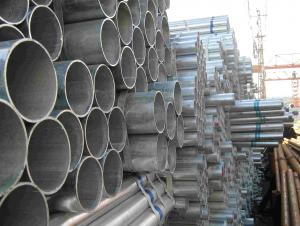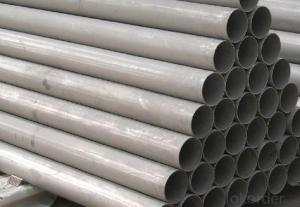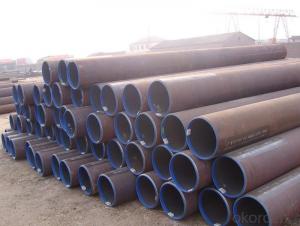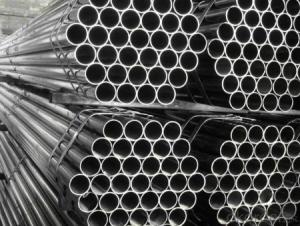seamless steel pipe for gas, water or oil industries
- Loading Port:
- Shanghai
- Payment Terms:
- TT OR LC
- Min Order Qty:
- 25 m.t.
- Supply Capability:
- 5000 m.t./month
OKorder Service Pledge
OKorder Financial Service
You Might Also Like
Specifications
1.ASTM A106/A53 GR.B
2.Outer diameter:10.3-194.4mm
3.Wall thickness:6.5-59mm
4.Cer:ISO9001:2008,API
Seamless steel pipe
(1) Standard: GB8163, ASTM A106/A53/API 5L
(2) Material: 10#, 20#, 16Mn, A106Gr.A/B/C,
(3)Specification: O.D: 21.3mm-711.2 mm
(4) W.T: 2.11mm-59.54mm
Technical Parameters of Seamless Steel Pipe
A53: Chemical components and mechanical property
Stan- dard | Trade mark | Chemical components | Mechanical property | ||||||||||
| C | Si | Mn | P,S | Cu | Ni | Mo | Cr | V | Tensile Strength | Yield Strength | Elongation | ||
ASTM A53 | A | ≤0.25 | / | ≤0.92 | ≤0.05 | ≤0.06 | ≤0.40 | ≤0.15 | ≤0.40 | ≤0.08 | ≥330 | ≥205 | ≥29.5 |
| B | ≤0.30 | / | ≤1.2 | ≤0.05 | ≤0.06 | ≤0.40 | ≤0.15 | ≤0.40 | ≤0.08 | ≥415 | ≥240 | ≥29.5 | |
A106: Chemical components and mechanical property
| Stan-dard | Trade mark | Chemical components | Mechanical property | ||||||||||
| C | Si | Mn | P,S | Cu | Ni | Mo | Cr | V | Tensile Strength | Yield Strength | Elongation | ||
ASTM A106 | B | ≤0.30 | ≥0.10 | 0.29-1.06 | ≤0.035 | ≤0.40 | ≤0.40 | ≤0.15 | ≤0.40 | ≤0.08 | ≥415 | ≥240 | ≥30 |
| C | ≤0.35 | ≥0.10 | 0.29-1.06 | ≤0.035 | ≤0.40 | ≤0.40 | ≤0.15 | ≤0.40 | ≤0.08 | ≥485 | ≥275 | ≥30 | |
PSL 1: Chemical components and mechanical property
| Class and Sort | Chemical components | Mechanical property | |||||||
| C(Max) | Mn(Max) | P(Max) | S(Max) | Tensile Strength(Min) | Yield Strength(Min) | ||||
| A25 | CL I | 0.21 | 0.60 | 0.030 | 0.030 | 45.000 | 310 | 25.000 | 172 |
| CL II | 0.21 | 0.60 | 0.030 | 0.030 | |||||
| A | 0.22 | 0.90 | 0.030 | 0.030 | 48.000 | 331 | 30.000 | 207 | |
| B | 0.28 | 1.20 | 0.030 | 0.030 | 60.000 | 414 | 35.000 | 241 | |
| X42 | 0.28 | 1.30 | 0.030 | 0.030 | 60.000 | 414 | 42.000 | 290 | |
| X46 | 0.28 | 1.40 | 0.030 | 0.030 | 63.000 | 434 | 46.000 | 317 | |
| X52 | 0.28 | 1.40 | 0.030 | 0.030 | 66.000 | 455 | 52.000 | 359 | |
| X56 | 0.28 | 1.40 | 0.030 | 0.030 | 71.000 | 490 | 56.000 | 386 | |
| X60 | 0.28 | 1.40 | 0.030 | 0.030 | 75.000 | 517 | 60.000 | 414 | |
| X65 | 0.28 | 1.40 | 0.030 | 0.030 | 77.000 | 531 | 65.000 | 448 | |
| X70 | 0.28 | 1.40 | 0.030 | 0.030 | 82.000 | 565 | 70.000 | 483 | |
Our catalog of Seamless steel pipe
| item | material | standard | specification (OD*WT)mm | usage |
| alloy pipe | Cr5Mo. 15CrMo 13CrMo44 12Cr1MoV P22 T91,P91,P9, T9 Wb36 | GB5310-95 GB9948-88 ASTMA335/A335M ASTMA213/213M DIN17175-79 JISG3467-88 JISG3458-88 | 16-824*2-100 | The seamless steal pipes features resistance to high pressure, high/low temperature and corrosion and is used in the industries of petroleum, chemical engineering and. Electric power as well as boiler |
High-pressure boiler pipe | 20G,A106, ST 45 | GB5310-95 ASTM A 106-99 DIN17175-79 | 14-630*2-80 | Temperature-resistant seamless steel pipe far high-pressure boiler |
Seamless pipes for petroleum | 20, 12CrMo, 15CrMo | GB9948-88 | 10-530*1.5-36 | Boiler pipes for refinery, heat-exchanging pipes, seamless steel pipes for pipeline |
High-pressure Seamless pipes for fertilizer making equipment | 20, 16Mn, Q345 | GB6479-2000 | 18-530*3-40 | Fertilizer making equipment and pipe line |
Low and medium- pressure boiled pipe | 10,20 | GB3087-1999 | 10-530*2-40 | Over-heat pipe for low and medium pressure boiler, boiling water pipe, locomotive smoke pipe(big and small) |
| Fluid pipe | 20, Q345 | GB/T8163-1999 | 8-630*1.0-40 | Fluid feeding |
| Structural pipe | 20, Q345 10, 20,35,45, 16Mn,Q345B | GB/T8162-1999 | 6-1020*1.5-100 | For common structure |
| Line pipe | Gr.B | API | 60-630*1.5-40 | Carrying gas, water or oil in the industries of petroleum and natural gas |
Hydraulic prop pipe | 27SiMn | GB/T17396-1998 | 70-377*9-40 | Hydraulic support and prop |
- Q: DN80 seamless steel tube, what is the standard thickness?
- Generally speaking, the diameter of the pipe can be divided into outer diameter, inner diameter and nominal diameter. Tubes are made of seamless steel tubes. The outer diameter of the tubes is indicated by the letter D, followed by additional outer diameter dimensions and wall thicknesses such as seamless steel tubes with an outer diameter of 108.
- Q: Can steel pipes be used for fire sprinkler systems?
- Yes, steel pipes can be used for fire sprinkler systems. Steel pipes are commonly used in fire sprinkler systems due to their durability, high heat resistance, and ability to withstand high water pressure. They are also cost-effective and widely available, making them a popular choice for such systems.
- Q: How do you calculate the bending moment of a steel pipe?
- The bending moment of a steel pipe can be calculated using the formula M = F * d, where M is the bending moment, F is the applied force, and d is the distance from the neutral axis to the point where the bending moment is being calculated.
- Q: Can steel pipes be used for irrigation systems?
- Yes, steel pipes can be used for irrigation systems. Steel pipes are known for their durability, strength, and resistance to corrosion, making them suitable for use in irrigation systems where they may be exposed to water and various environmental conditions. Additionally, steel pipes can handle high water pressure and are available in different sizes, allowing for efficient water distribution throughout the irrigation system.
- Q: How are steel pipes used in the manufacturing of agricultural machinery?
- Steel pipes are commonly used in the manufacturing of agricultural machinery for various purposes such as structural support, fluid transportation, and protection. They are utilized to create the framework and chassis of the machinery, providing strength and durability. Steel pipes are also used to transport fluids such as fuel, water, and chemicals throughout the machinery. Additionally, steel pipes can be used to protect vulnerable components from external elements, ensuring the longevity and reliability of the agricultural machinery.
- Q: What are the challenges faced in transporting steel pipes?
- Some of the challenges faced in transporting steel pipes include their large size and weight, which can make them difficult to handle and transport. Additionally, their shape can make it challenging to secure them properly during transportation to prevent damage or accidents. The corrosive nature of steel pipes can also pose a challenge, as special precautions need to be taken to protect them from rust or other forms of damage during transportation. Finally, the cost of transportation can be a challenge, as steel pipes often require specialized equipment and vehicles, which can be expensive to rent or purchase.
- Q: How do you calculate the pipe flow rate coefficient for steel pipes?
- To calculate the pipe flow rate coefficient for steel pipes, you need to consider various factors related to the pipe's dimensions, material properties, and the fluid flowing through it. The pipe flow rate coefficient, also known as the discharge coefficient (Cd), is a dimensionless value that represents the efficiency of fluid flow through a pipe. Here are the steps to calculate the pipe flow rate coefficient for steel pipes: 1. Determine the inside diameter (ID) of the steel pipe. This is the measurement of the internal cross-sectional area of the pipe through which the fluid flows. 2. Calculate the pipe's cross-sectional area (A) using the formula: A = π * (ID/2)^2. Here, π is the mathematical constant pi (approximately 3.14). 3. Measure the pressure drop (∆P) across the steel pipe. This is the difference in pressure between the pipe's inlet and outlet. 4. Measure the fluid flow rate (Q) through the pipe. This can be done using flow meters or by measuring the time it takes for a known volume of fluid to pass through the pipe. 5. Calculate the velocity (V) of the fluid flowing through the pipe using the formula: V = Q / A. Here, Q is the fluid flow rate and A is the cross-sectional area of the pipe. 6. Calculate the pipe flow rate coefficient (Cd) using the formula: Cd = Q / (A * √(2 * ∆P / ρ)). Here, ρ is the fluid density. This formula is derived from the Bernoulli's equation and takes into account the pressure drop, fluid flow rate, and fluid density. It is important to note that the pipe flow rate coefficient for steel pipes can vary depending on factors such as pipe roughness, fluid viscosity, and Reynolds number. Therefore, it is advisable to consult relevant engineering standards, such as the Darcy-Weisbach equation or the Hazen-Williams equation, to obtain more accurate values for specific pipe configurations and fluid properties.
- Q: How are steel pipes protected from corrosion in corrosive environments?
- Steel pipes are protected from corrosion in corrosive environments through various methods such as applying protective coatings, using cathodic protection systems, and implementing corrosion inhibitors.
- Q: What's the difference between hot dip galvanizing and cold galvanizing? Which kind of galvanizing method is good?
- There are two kinds of hot dip galvanizing, zinc plated and non galvanized. The flowers must be hot-dip galvanized, without flowers, similar to galvanized.
- Q: What is the cost of steel pipes?
- The cost of steel pipes can vary depending on various factors such as size, grade, quantity, and current market conditions. It is best to contact a supplier or check with local suppliers to get an accurate and up-to-date price quote.
Send your message to us
seamless steel pipe for gas, water or oil industries
- Loading Port:
- Shanghai
- Payment Terms:
- TT OR LC
- Min Order Qty:
- 25 m.t.
- Supply Capability:
- 5000 m.t./month
OKorder Service Pledge
OKorder Financial Service
Similar products
Hot products
Hot Searches
Related keywords
